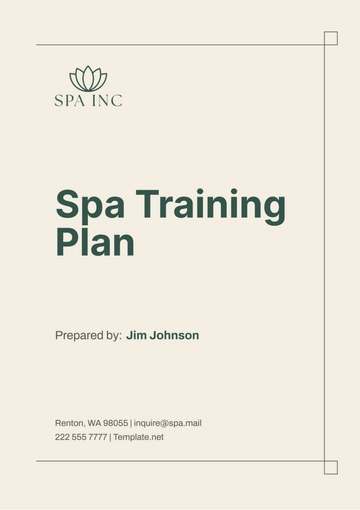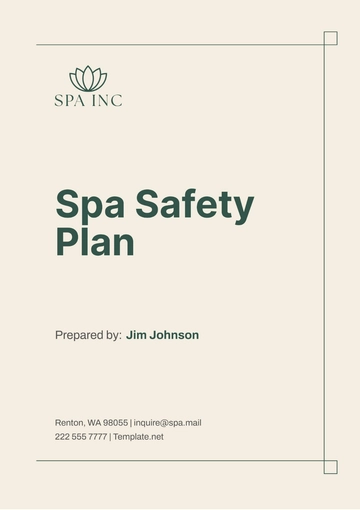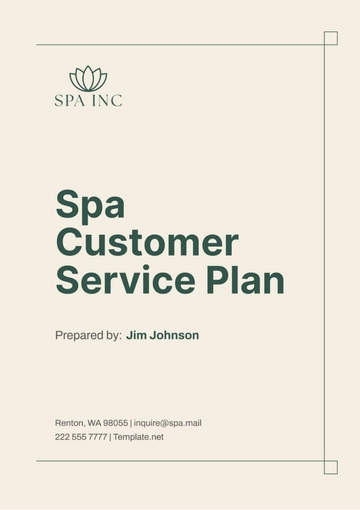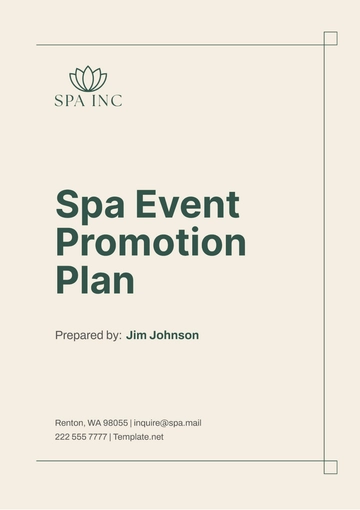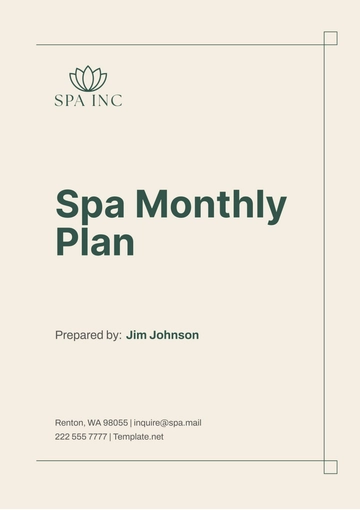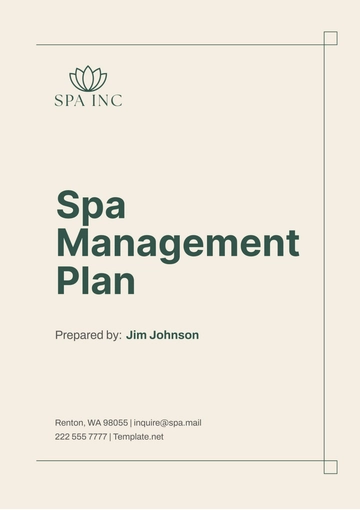Free Spa Management Plan
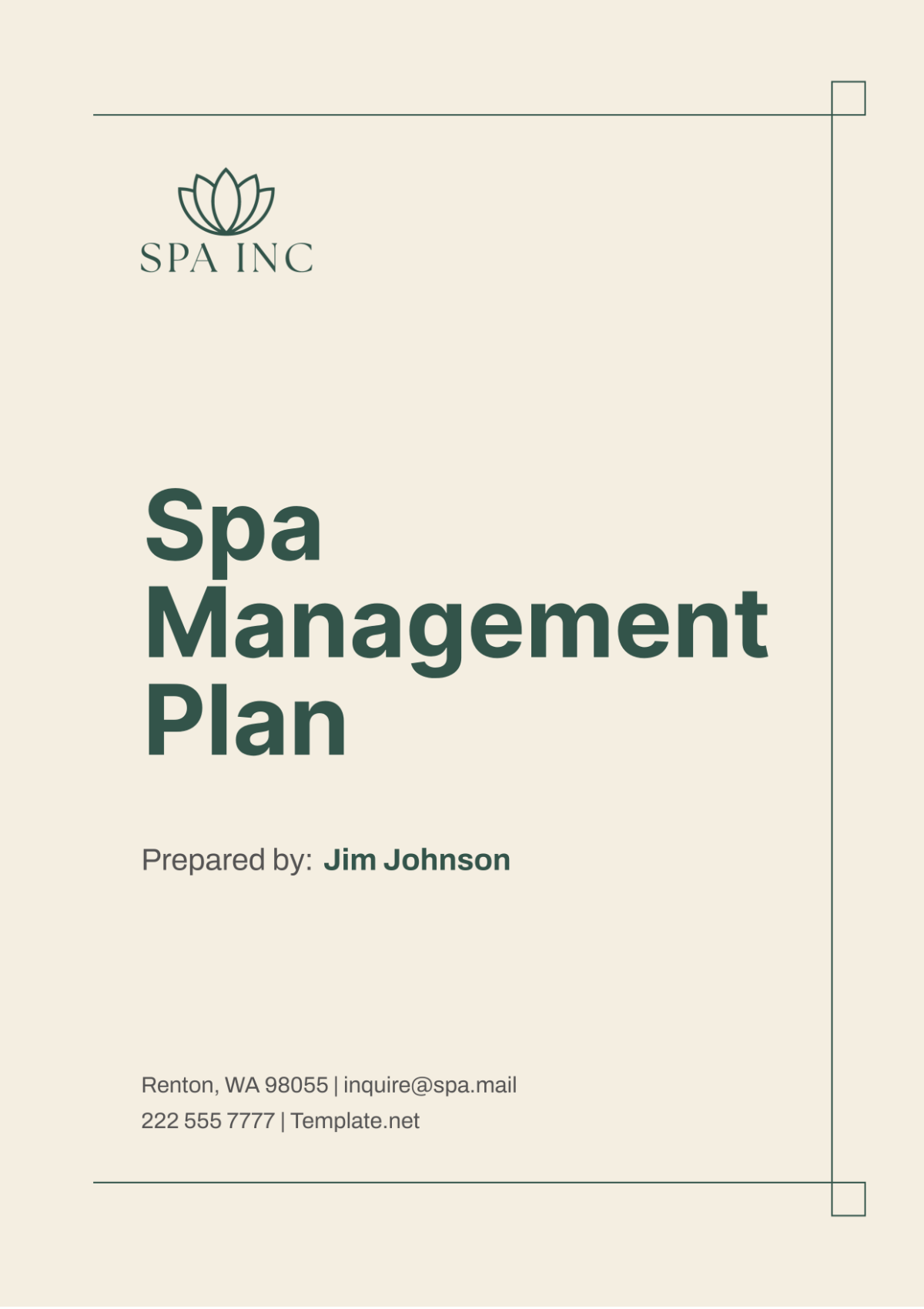
1. Introduction and Objectives
The purpose of this Spa Management Plan is to provide a comprehensive framework for managing the operations of [Your Company Name]. This plan outlines the objectives, scope, responsibilities, timeline, resource allocation, communication strategy, risk management, quality assurance/control, monitoring, evaluation mechanisms, and stakeholder engagement specific to spa management.
Objectives
Ensure the highest quality of spa services: Maintain top-tier service standards through regular staff training, quality control measures, and customer feedback mechanisms.
Enhance customer satisfaction and loyalty: Implement personalized services, loyalty programs, and consistent follow-ups to foster long-term relationships with clients.
Efficiently manage resources and staff: Optimize resource allocation, streamline staff schedules, and ensure all employees are well-trained and motivated.
Implement effective communication strategies: Establish clear communication channels within the team and with clients to ensure transparency and responsiveness.
Mitigate risks and ensure safety standards: Adhere to industry regulations, conduct regular safety audits, and maintain strict hygiene protocols.
2. Scope Description
The scope of this Management Plan covers all operational aspects of [Your Company Name]. This includes employee management, customer service, facility maintenance, financial management, marketing activities, and compliance with local regulations.
Specific Responsibilities
Spa Manager:
Oversee daily operations: Ensure smooth functioning of all spa activities, from client bookings to service delivery.
Ensure proper training and development of staff: Organize regular training sessions and professional development opportunities for all employees.
Monitor financial performance: Track revenue, expenses, and profitability, and make adjustments as necessary to achieve financial goals.
Develop marketing strategies: Create and implement marketing campaigns to attract new clients and retain existing ones.
Ensure compliance with health and safety regulations: Regularly review and update safety protocols to meet regulatory requirements and industry standards.
Spa Staff:
Deliver high-quality services: Provide exceptional treatments and consultations to clients, ensuring satisfaction and repeat business.
Maintain cleanliness and hygiene standards: Adhere to stringent cleanliness protocols to ensure a safe and welcoming environment.
Assist in promotional activities: Participate in marketing and promotional events to increase the spa's visibility and attract new clients.
Report issues to the Spa Manager: Communicate any operational challenges or client concerns promptly to ensure timely resolution.
3. Timeline and Milestones
This chapter outlines the key milestones and target dates for achieving them, ensuring the spa's operations are launched and maintained efficiently. Each milestone has a designated responsible party to ensure accountability and smooth execution.
Milestone | Target Date | Responsible Party |
|---|---|---|
Initial Planning Phase | 01/01/2050 | Spa Manager |
Staff Recruitment | 01/15/2050 | HR Department |
Facility Setup | 02/01/2050 | Operations Team |
Marketing Campaign Launch | 02/15/2050 | Marketing Department |
Opening Day | 03/01/2050 | Spa Manager |
Detailed Milestones
Initial Planning Phase: Develop the strategic plan, finalize the budget, and set up initial operations. This phase lays the foundation for all subsequent activities.
Staff Recruitment: Hire qualified professionals, including spa therapists, receptionists, and cleaning staff. Ensure a comprehensive onboarding process.
Facility Setup: Prepare the spa facility, including the installation of equipment, arrangement of treatment rooms, and procurement of necessary supplies.
Marketing Campaign Launch: Implement marketing strategies to generate buzz and attract clients. Utilize social media, email campaigns, and local advertising.
Opening Day: Officially launch the spa, ensuring all systems are operational and staff are ready to deliver exceptional service.
4. Resource Allocation
Effective resource allocation is crucial for the successful operation of the spa. This chapter details the allocation of human, financial, and physical resources necessary to achieve the spa's objectives.
Human Resources
Spa Manager: [Name], [Email]
Receptionists: [Number] individuals responsible for client bookings and front-desk operations.
Spa Therapists: [Number] individuals skilled in various treatments and therapies.
Cleaning Staff: [Number] individuals tasked with maintaining cleanliness and hygiene.
Financial Resources
Initial Investment: [Amount] allocated for setting up the spa, including facility renovation, equipment purchase, and initial marketing.
Monthly Operational Budget: [Amount] covering ongoing expenses such as salaries, utilities, supplies, and marketing.
Physical Resources
Facility Location: [Your Company Address], strategically chosen for accessibility and visibility.
Equipment: [List of Equipment], including massage tables, hydrotherapy tubs, skincare devices, and other essential tools.
Supplies: [List of Supplies], such as skincare products, towels, cleaning supplies, and wellness supplements.
5. Communication Plan
Effective communication is crucial for the smooth operation of the spa. This chapter outlines the communication channels and strategies to ensure clear and consistent information flow among staff and stakeholders.
Communication Channels
Email: Regular updates to staff and stakeholders regarding operational changes, upcoming promotions, and important announcements. Email will be used for both internal and external communication.
Meetings: Weekly team meetings to discuss ongoing activities, address any issues, and plan for the week ahead. Monthly review meetings to assess performance and adjust strategies as necessary.
Social Media: Engage with customers through [Your Company Social Media] platforms such as Facebook, Instagram, and Twitter. Use these channels to promote services, share customer testimonials, and announce special offers.
Website: Update services and promotions on [Your Company Website]. The website will also serve as a booking platform and a source of information for clients about the spa's offerings and policies.
Communication Strategies
Internal Communication: Foster an open and collaborative environment where staff feel comfortable sharing ideas and concerns. Use a combination of formal and informal channels to keep everyone informed and engaged.
External Communication: Maintain a consistent brand voice across all external communication channels. Ensure that clients receive timely and relevant information about the spa's services and promotions.
Crisis Communication: Develop a crisis communication plan to address potential issues such as service disruptions, client complaints, or health and safety incidents. Designate a spokesperson and establish protocols for handling media inquiries and client communications.
6. Risk Management
Risk management is a critical component of the Spa Management Plan. Identifying potential risks and developing strategies to mitigate them ensures the spa operates smoothly and sustainably. This section outlines potential risks and the mitigation strategies to address them.
Potential Risks
Health and Safety Incidents
Impact: Health and safety incidents can lead to severe consequences, including injuries to clients or staff, legal liabilities, and reputational damage.
Examples: Slips and falls, allergic reactions to products, equipment malfunctions.
Customer Dissatisfaction
Impact: Customer dissatisfaction can result in negative reviews, loss of clientele, and a decline in revenue.
Examples: Poor service quality, long waiting times, unprofessional staff behavior.
Financial Shortfalls
Impact: Financial instability can threaten the viability of the spa, leading to cutbacks, layoffs, or closure.
Examples: Insufficient revenue, unexpected expenses, poor financial management.
Staff Turnover
Impact: High staff turnover can disrupt operations, increase recruitment costs, and affect service consistency.
Examples: Employee dissatisfaction, lack of career development opportunities, competitive job market.
Mitigation Strategies
Implement Strict Hygiene and Safety Protocols
Details: Establish comprehensive hygiene and safety standards, including regular sanitation of facilities, proper use of equipment, and adherence to industry best practices.
Actions: Regularly update protocols, provide training to staff, and conduct routine inspections to ensure compliance.
Conduct Regular Customer Satisfaction Surveys
Details: Implement a systematic approach to gathering and analyzing customer feedback to identify areas for improvement.
Actions: Distribute surveys after each visit, review feedback monthly, and address common concerns promptly.
Maintain a Contingency Fund
Details: Allocate a portion of the budget to a contingency fund to cover unexpected expenses and financial shortfalls.
Actions: Regularly review financial statements, adjust the fund as needed, and use the fund judiciously.
Provide Continuous Training and Development for Staff
Details: Invest in ongoing training programs to enhance the skills and knowledge of staff, ensuring high service standards and job satisfaction.
Actions: Schedule regular training sessions, offer professional development opportunities, and create a positive work environment.
7. Quality Assurance/Control
Ensuring the quality of services is paramount to the success of [Your Company Name]. This section outlines the measures that will be implemented to maintain high standards and continuously improve service quality.
Quality Audits
Details: Conduct monthly internal audits to evaluate the quality of services and facilities. These audits will assess various aspects, including cleanliness, staff performance, and adherence to protocols.
Actions: Develop audit checklists, assign audit responsibilities, and review audit results with the management team to implement necessary improvements.
Customer Feedback
Details: Regularly collect and analyze customer feedback to understand their experiences and identify areas for improvement. Customer feedback is invaluable for making informed decisions and enhancing service quality.
Actions: Use feedback forms, online reviews, and direct communication to gather feedback. Create a feedback loop to ensure that all feedback is addressed and acted upon.
Staff Training
Details: Implement ongoing training programs to keep staff updated on the latest industry trends, techniques, and best practices. Continuous education helps maintain high service standards and fosters professional growth.
Actions: Schedule regular training sessions, provide access to external training resources, and encourage staff to pursue certifications and advanced training.
8. Monitoring and Evaluation
Monitoring and evaluation are crucial for assessing the effectiveness of the spa's operations and identifying areas for improvement. This section outlines the key metrics and evaluation mechanisms that will be used to track performance.
Metrics
Customer Satisfaction Score
Details: Measure customer satisfaction through surveys and feedback forms. A high satisfaction score indicates that the spa is meeting client expectations.
Actions: Regularly review and analyze satisfaction scores, and implement improvements based on feedback.
Employee Performance Metrics
Details: Evaluate staff performance based on various criteria, including service quality, professionalism, and customer feedback.
Actions: Conduct regular performance reviews, set performance targets, and provide constructive feedback to employees.
Financial Performance Indicators
Details: Track key financial metrics, such as revenue, expenses, profit margins, and cash flow. Financial health is a critical indicator of the spa's overall performance.
Actions: Regularly review financial statements, compare performance against budget, and adjust strategies as needed.
Facility Maintenance Records
Details: Maintain records of facility maintenance activities to ensure that the spa remains in excellent condition. Proper maintenance contributes to a safe and pleasant environment for clients and staff.
Actions: Schedule regular maintenance checks, keep detailed records, and address maintenance issues promptly.
Evaluation Mechanisms
Quarterly Reviews
Details: Conduct comprehensive performance reviews every quarter to assess progress towards goals and identify areas for improvement.
Actions: Review key metrics, gather input from staff and stakeholders, and develop action plans to address identified issues.
Annual Report
Details: Prepare a detailed annual report to evaluate the spa's overall performance and highlight significant achievements and areas for improvement.
Actions: Compile data from various sources, analyze trends, and present findings to the management team and stakeholders.
9. Stakeholder Engagement
Engaging with stakeholders, including customers, staff, suppliers, and local authorities, is critical for the success of [Your Company Name]. This section outlines the strategies for regular communication and involvement in decision-making processes.
Customers
Details: Maintain regular communication with customers to understand their needs and preferences. Implement loyalty programs to encourage repeat business.
Actions: Conduct customer surveys, hold customer appreciation events, and provide exclusive offers to loyal clients.
Staff
Details: Involve staff in planning and decision-making processes to foster a sense of ownership and commitment. Regularly communicate with staff to keep them informed and motivated.
Actions: Hold regular team meetings, provide opportunities for staff input, and recognize and reward outstanding performance.
Suppliers
Details: Build long-term relationships with reliable suppliers to ensure a consistent supply of high-quality products and services.
Actions: Conduct regular supplier evaluations, negotiate favorable terms, and maintain open lines of communication.
Local Authorities
Details: Ensure compliance with local regulations and actively participate in community initiatives to build a positive reputation.
Actions: Regularly review regulatory requirements, participate in local business associations, and support community events and programs.
10. Flexibility and Adaptability
The Management Plan is designed to be flexible and adaptable to changes in the market or operational challenges. Regular reviews and updates will be made to ensure the plan remains relevant and effective.
Flexibility
Details: The spa management team will regularly review the plan and make adjustments as necessary to respond to changing circumstances. This may include modifying strategies, reallocating resources, or revising goals.
Actions: Schedule regular review meetings, gather input from stakeholders, and update the plan based on new information and insights.
Adaptability
Details: The spa will adopt a proactive approach to identify and address potential challenges before they become significant issues. This includes staying informed about industry trends, economic conditions, and customer preferences.
Actions: Monitor industry reports, attend relevant conferences and workshops, and regularly communicate with clients and staff to gather feedback and stay ahead of trends.
By incorporating comprehensive risk management strategies, quality assurance/control measures, and robust monitoring and evaluation mechanisms, [Your Company Name] will ensure the spa's operations are efficient, effective, and aligned with its strategic objectives. Engaging stakeholders and maintaining flexibility will further support the spa's ability to adapt to changes and achieve long-term success.
11. Conclusion
This Spa Management Plan serves as a comprehensive guide for the successful management of [Your Company Name]'s spa operations. It encompasses the essential aspects of operational management, ensuring a structured approach to achieving objectives and maintaining high standards. By adhering to this plan, the spa can enhance its services, satisfy its customers, and ensure a productive and harmonious working environment for its staff.
- 100% Customizable, free editor
- Access 1 Million+ Templates, photo’s & graphics
- Download or share as a template
- Click and replace photos, graphics, text, backgrounds
- Resize, crop, AI write & more
- Access advanced editor
Achieve operational excellence in your spa with Template.net's Spa Management Plan Template. Tailored for spa managers, this template offers a comprehensive framework to streamline day-to-day operations, from staff scheduling to inventory management. Utilize our AI editor tool to customize the template to your spa's unique needs, ensuring efficient management and exceptional guest experiences. Elevate your spa's performance with this versatile management plan template from Template.net.
You may also like
- Finance Plan
- Construction Plan
- Sales Plan
- Development Plan
- Career Plan
- Budget Plan
- HR Plan
- Education Plan
- Transition Plan
- Work Plan
- Training Plan
- Communication Plan
- Operation Plan
- Health And Safety Plan
- Strategy Plan
- Professional Development Plan
- Advertising Plan
- Risk Management Plan
- Restaurant Plan
- School Plan
- Nursing Home Patient Care Plan
- Nursing Care Plan
- Plan Event
- Startup Plan
- Social Media Plan
- Staffing Plan
- Annual Plan
- Content Plan
- Payment Plan
- Implementation Plan
- Hotel Plan
- Workout Plan
- Accounting Plan
- Campaign Plan
- Essay Plan
- 30 60 90 Day Plan
- Research Plan
- Recruitment Plan
- 90 Day Plan
- Quarterly Plan
- Emergency Plan
- 5 Year Plan
- Gym Plan
- Personal Plan
- IT and Software Plan
- Treatment Plan
- Real Estate Plan
- Law Firm Plan
- Healthcare Plan
- Improvement Plan
- Media Plan
- 5 Year Business Plan
- Learning Plan
- Marketing Campaign Plan
- Travel Agency Plan
- Cleaning Services Plan
- Interior Design Plan
- Performance Plan
- PR Plan
- Birth Plan
- Life Plan
- SEO Plan
- Disaster Recovery Plan
- Continuity Plan
- Launch Plan
- Legal Plan
- Behavior Plan
- Performance Improvement Plan
- Salon Plan
- Security Plan
- Security Management Plan
- Employee Development Plan
- Quality Plan
- Service Improvement Plan
- Growth Plan
- Incident Response Plan
- Basketball Plan
- Emergency Action Plan
- Product Launch Plan
- Spa Plan
- Employee Training Plan
- Data Analysis Plan
- Employee Action Plan
- Territory Plan
- Audit Plan
- Classroom Plan
- Activity Plan
- Parenting Plan
- Care Plan
- Project Execution Plan
- Exercise Plan
- Internship Plan
- Software Development Plan
- Continuous Improvement Plan
- Leave Plan
- 90 Day Sales Plan
- Advertising Agency Plan
- Employee Transition Plan
- Smart Action Plan
- Workplace Safety Plan
- Behavior Change Plan
- Contingency Plan
- Continuity of Operations Plan
- Health Plan
- Quality Control Plan
- Self Plan
- Sports Development Plan
- Change Management Plan
- Ecommerce Plan
- Personal Financial Plan
- Process Improvement Plan
- 30-60-90 Day Sales Plan
- Crisis Management Plan
- Engagement Plan
- Execution Plan
- Pandemic Plan
- Quality Assurance Plan
- Service Continuity Plan
- Agile Project Plan
- Fundraising Plan
- Job Transition Plan
- Asset Maintenance Plan
- Maintenance Plan
- Software Test Plan
- Staff Training and Development Plan
- 3 Year Plan
- Brand Activation Plan
- Release Plan
- Resource Plan
- Risk Mitigation Plan
- Teacher Plan
- 30 60 90 Day Plan for New Manager
- Food Safety Plan
- Food Truck Plan
- Hiring Plan
- Quality Management Plan
- Wellness Plan
- Behavior Intervention Plan
- Bonus Plan
- Investment Plan
- Maternity Leave Plan
- Pandemic Response Plan
- Succession Planning
- Coaching Plan
- Configuration Management Plan
- Remote Work Plan
- Self Care Plan
- Teaching Plan
- 100-Day Plan
- HACCP Plan
- Student Plan
- Sustainability Plan
- 30 60 90 Day Plan for Interview
- Access Plan
- Site Specific Safety Plan
